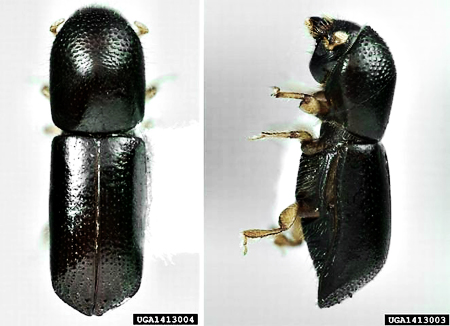Xyleborus glabratus
Redbay Ambrosia beetle
Synonym(s):
Class: Insecta
Order: Coleoptera
Family: Curculionidae

Photographer: Unknown
Source: http://cisr.ucr.edu/
Description
Adult Description: The redbay ambrosia beetle (Xyleborus glabratus) is a dark colored, bullet shaped beetle with small puncture-like dents covering the elytra, and is 2 mm long when mature. The redbay ambrosia beetle is a member of the family Curculionidae along with weevils, which can be identified with a characteristic snout representing modified mandibles for taking up nutrients. Positive identification of X. glabratus is impossible without the help of a professional, but the glaborous upper surface and abrupt apical declivity may help distinguish this invasive beetle from other native species.
Larva Description: Redbay ambrosia beetle larvae, consistent with most beetles, are legless, white grubs. The head capsule of the redbay ambrosia beetle grub is amber colored. These flightless grubs are found feeding on infected trees beneath or on the surface of the bark.
Host Plants: Redbay (Persea borbonia), sassafras (Sassafras albidum), avocado (Persea americana), swampbay (Persea palustris), pondspice (Litsea aestivalis), pondberry (Lindera melissifolia), and camphor (Cinnamomum camphora)
Ecological Threat: The redbay ambrosia beetle is a known vector of the vascular fungus Raffaelea lauricola, which causes the host plant to wilt and die within a matter of months or even weeks. This insect-disease complex is referred to as laurel wilt in literature. Lauraceous hosts are in danger of significant damage and population decrease from the introduction of the redbay ambrosia beetle. Flight allows the beetle to transfer the fungus to hosts rapidly with an increase of redbay mortality of 10% to 15% in 15 months in Florida. Areas in South Carolina are near complete mortality of redbay populations. The loss of redbay is detrimental to wildlife that utilize the plant as fruit. Foliage and seed of redbay is eaten by songbirds, wild turkeys, quail, deer, and black bear. Economic concern arises from the patterns of host use seen in avocado plants by the redbay ambrosia beetle. Avocado plants are a crucial part of Florida, California, and other state's agriculture. Damage potential to the avocado trade is uncertain if the redbay ambrosia beetle spreads to avocado plants in Florida and other states.
Click here for more information on the vascular fungus Raffaelea lauricola
Biology: Minimal information is available specific to this new invasive species regarding the biology. However, it is assumed that reproduction and feeding is similar to other members of the genus Xyleborus. Other ambrosia beetls are known to feed on fungi inoculated in the wood rather than the wood itself. This is facilitated by thin extended mouthparts in the form of a long snout. At the base of the mandible is a specialized structure called the mycangia, which is used to carry the fungal spores. Male redbay ambrosia beetles are smaller than females, flightless, and haploid. Exact generation time is unknown, but estimated to last 50-60 days based on observations.
History: In 2002 the redbay ambrosia beetle was discovered near Port Wentworth, Georgia by chance in a survey trap. Within three years the beetle spread through the southeast U.S. and was associated with death to ambrosia and sassafras trees in Florida. Experts believe introduction of the redbay ambrosia beetle was facilitated by solid wood packing materials such as crates or pallets that the beetle was feeding on undetected.
U.S. Habitat: The redbay ambrosia beetle can be found in areas where host plants are present, most commonly found on redbay and sassafras hosts. Within the U.S. the redbay ambrosia beetle is found feeding on healthy trees and shrubs. In areas where the beetle is native, stressed or dying trees are shrubs are utilized as host plants.
Distribution
Native Origin: India, Japan, Myanmar, and Taiwan
U.S. Present: FL, GA, MS, SC
Management
You can help prevent the spread of the redbay ambrosia beetle by avoiding the transport of firewood. Wood chips of infested trees should not be transported out of the area, but left on-sight as mulch. If its not possible to use the wood chips as much, try and leave them as locally as possible to prevent further spread. There are currently no chemical management options, but the experts at the University of Florida-Institute for Food and Agricultural Sciences are developing possible products.
Text References
Hanula, J.L., A.E. Mayfield III, S.W. Fraedrich, and R.J. Rabaglia. 2008. Biology and Host Associations of Redbay Ambrosia Beetle (Coleoptera: Curculionidae: Scolytinae), Exotic Vector of Laurel Wilt Killing Redbay Trees in the Southeastern United States. J. Econ. Entomol. 101(4): 1276-1286.
Mayfield, A.E. III, J.A. Smith, M. Hughes and T. J. Dresden. 2008a. First report of laurel wilt disease caused by Raffaelea sp. on Avocado in Florida. Plant Disease 92(6): 976.
Mayfield, A.E. III, J.E. Peña, J.H. Crane, J.A. Smith, C.L. Branch, E.D. Ottoson, and M. Hughes. 2008b. Ability of the redbay ambrosia beetle (Coleoptera: Curculionidae: Scolytinae) to bore into young avocado (Lauraceae) plants and transmit the laurel wilt pathogen (Raffaelea sp.). Florida Entomologist 91(3): 485-487.
Smith, J.A., L. Mount, A.E. Mayfield III, W.A. Lamborn, S.W Fraedrich. 2009. First report of laurel wilt disease caused by Raffaelea lauricola on Camphor in Florida and Georgia. Plant Disease 93(2): 198.
Internet Sources
http://www.freshfromflorida.com
 Texas Invasive Species Institute
Texas Invasive Species Institute